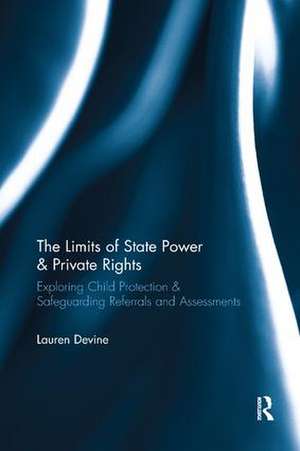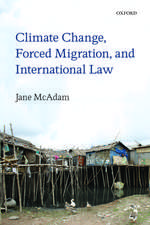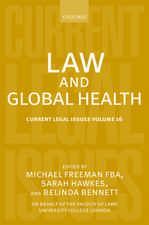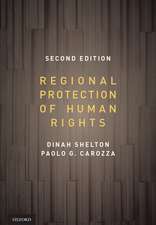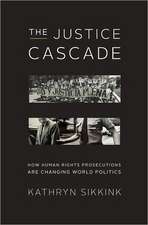The Limits of State Power & Private Rights: Exploring Child Protection & Safeguarding Referrals and Assessments
Autor Lauren Devineen Limba Engleză Paperback – 18 oct 2018
The Limits of State Power & Private Rights is ground-breaking in its approach to the subject and its detailed, critical analysis. Traditionally the subject matter of the book is considered within a welfare framework. The analysis in this book argues that a policing agenda is embedded within policy but without appropriate safeguards and controls, creating potentially irreconcilable tension described by the author as the ‘welfare/policing dichotomy’.
This book is of importance to academics, lawyers, social workers, policy makers, practitioners and service users. The book is written so as to be accessible to a multi-disciplinary audience, but is sufficiently detailed so as to be suitable for specialists and non-specialists alike in this subject area. The chapters include introductory and contextual sections as well as doctrinal, theoretical and socio-legal analysis. Although the focus is on the English system, the book is equally applicable to the many worldwide jurisdictions adopting the Anglo/American ‘child rights’ based framework of child protection. It is also of use as a comparative work in countries where a family support based system is practiced.
| Toate formatele și edițiile | Preț | Express |
|---|---|---|
| Paperback (1) | 411.22 lei 6-8 săpt. | |
| Taylor & Francis – 18 oct 2018 | 411.22 lei 6-8 săpt. | |
| Hardback (1) | 1109.18 lei 6-8 săpt. | |
| Taylor & Francis – 2 mar 2017 | 1109.18 lei 6-8 săpt. |
Preț: 411.22 lei
Nou
Puncte Express: 617
Preț estimativ în valută:
78.68€ • 82.38$ • 65.11£
78.68€ • 82.38$ • 65.11£
Carte tipărită la comandă
Livrare economică 05-19 aprilie
Preluare comenzi: 021 569.72.76
Specificații
ISBN-13: 9780367075590
ISBN-10: 0367075598
Pagini: 224
Ilustrații: 4 Tables, black and white; 5 Illustrations, black and white
Dimensiuni: 156 x 234 x 12 mm
Greutate: 0.34 kg
Ediția:1
Editura: Taylor & Francis
Colecția Routledge
Locul publicării:Oxford, United Kingdom
ISBN-10: 0367075598
Pagini: 224
Ilustrații: 4 Tables, black and white; 5 Illustrations, black and white
Dimensiuni: 156 x 234 x 12 mm
Greutate: 0.34 kg
Ediția:1
Editura: Taylor & Francis
Colecția Routledge
Locul publicării:Oxford, United Kingdom
Public țintă
PostgraduateCuprins
Introduction
Exploring the issue: State power and private rights
Central themes and structure of the book
Chapter 1 - Development of the State’s role: child welfare & family policing
The State’s developing role in children’s welfare: good intentions and opposing narratives
The development of child welfare principles
The development of State principles for the protection of children
Moving from parental autonomy to parental responsibility
The refocusing debate
Safeguarding and early intervention
Conclusion: the modern categorisation of levels of surveillance and interference
Chapter 2 - Defining and measuring the problem
Defining child abuse
Issues of measuring the prevalence of, and predicting, child abuse
Prevalence: measuring of the amount of child abuse in England
Measuring the outcome
Risk prediction: can child abuse be predicted and prevented?
Conclusion: issues of measuring success
Chapter 3 – Identifying families for policing
The modern surveillance role of the state: identifying children for referral
Introducing mass surveillance and recording of information about children: part of the e-Government agenda
Policing by surveillance of all families: intelligence gathering and its limits
Conclusion: the challenge of balancing consent and coercion in the surveillance framework
Chapter 4 - The policing of parents: social work involvement
Social work response to referrals: State power and private rights
The framework of assessment
The Munro review of child protection: final report, a child centred system and changes to Working Together to Safeguard Children
The Public Law Outline 2014
The process of assessment
Consensual assessment
Coercive assessment
Conclusion: issues of safeguards and controls over State powers of assessment
Chapter 5 – Paradigms, policy & policing
Smith’s schema: exploring the ‘fractured lens’
The stages of the assessment procedures in ‘child protection’ and ‘safeguarding’ schema
Conclusion: implications for assessment
Chapter 6 – The balance of State power and private rights: considering protections for children and parents
Moving from ‘ownership’ to ‘responsibility’: disowned children and the burden of policing parental responsibility
What is the legal and policy framework of ‘child protection’ and ‘safeguarding’ trying to achieve?
By what mechanisms is the legislative and policy framework trying to achieve its purpose?
The issue of families harmed by State surveillance and assessment
Defining harm
Unsubstantiated allegations and unfounded concerns
Conclusion: power imbalance and individual harm
Chapter 7 - The question of remedies
Complaints procedures and Judicial Review
Defamation
The European Convention on Human Rights 1950 and the Human Rights Act 1998
Common law negligence
Conclusion: remedies – an inadequate position
Chapter 8 – Reforming policy: the politics of change
The question of reform
Framework for a new approach
Privacy, data and consent: taking the Anderson recommendations seriously
Referrals: improving methods of making and recording referrals
Assessments: a bespoke investigatory body and code of practice
Outcomes: issues of exoneration and redress in unsubstantiated cases
Specific remedies in unsubstantiated cases
Conclusion: rebalancing – the basis for reform
Conclusion
Index
Exploring the issue: State power and private rights
Central themes and structure of the book
Chapter 1 - Development of the State’s role: child welfare & family policing
The State’s developing role in children’s welfare: good intentions and opposing narratives
The development of child welfare principles
The development of State principles for the protection of children
Moving from parental autonomy to parental responsibility
The refocusing debate
Safeguarding and early intervention
Conclusion: the modern categorisation of levels of surveillance and interference
Chapter 2 - Defining and measuring the problem
Defining child abuse
Issues of measuring the prevalence of, and predicting, child abuse
Prevalence: measuring of the amount of child abuse in England
Measuring the outcome
Risk prediction: can child abuse be predicted and prevented?
Conclusion: issues of measuring success
Chapter 3 – Identifying families for policing
The modern surveillance role of the state: identifying children for referral
Introducing mass surveillance and recording of information about children: part of the e-Government agenda
Policing by surveillance of all families: intelligence gathering and its limits
Conclusion: the challenge of balancing consent and coercion in the surveillance framework
Chapter 4 - The policing of parents: social work involvement
Social work response to referrals: State power and private rights
The framework of assessment
The Munro review of child protection: final report, a child centred system and changes to Working Together to Safeguard Children
The Public Law Outline 2014
The process of assessment
Consensual assessment
Coercive assessment
Conclusion: issues of safeguards and controls over State powers of assessment
Chapter 5 – Paradigms, policy & policing
Smith’s schema: exploring the ‘fractured lens’
The stages of the assessment procedures in ‘child protection’ and ‘safeguarding’ schema
Conclusion: implications for assessment
Chapter 6 – The balance of State power and private rights: considering protections for children and parents
Moving from ‘ownership’ to ‘responsibility’: disowned children and the burden of policing parental responsibility
What is the legal and policy framework of ‘child protection’ and ‘safeguarding’ trying to achieve?
By what mechanisms is the legislative and policy framework trying to achieve its purpose?
The issue of families harmed by State surveillance and assessment
Defining harm
Unsubstantiated allegations and unfounded concerns
Conclusion: power imbalance and individual harm
Chapter 7 - The question of remedies
Complaints procedures and Judicial Review
Defamation
The European Convention on Human Rights 1950 and the Human Rights Act 1998
Common law negligence
Conclusion: remedies – an inadequate position
Chapter 8 – Reforming policy: the politics of change
The question of reform
Framework for a new approach
Privacy, data and consent: taking the Anderson recommendations seriously
Referrals: improving methods of making and recording referrals
Assessments: a bespoke investigatory body and code of practice
Outcomes: issues of exoneration and redress in unsubstantiated cases
Specific remedies in unsubstantiated cases
Conclusion: rebalancing – the basis for reform
Conclusion
Index
Descriere
The Limits of State Power & Private Rights: Exploring Child Protection & Safeguarding Referrals and Assessments examines in detail the UK child protection and safeguarding system, exploring its theoretical and legal basis and implications in modern society.
